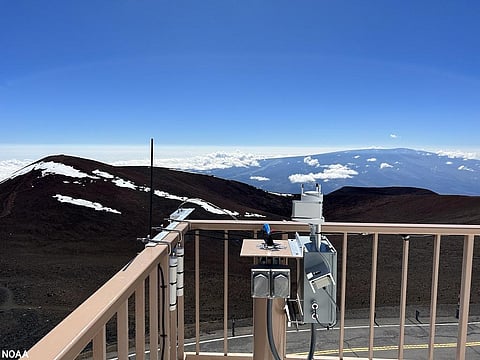

Levels of heat-trapping carbon dioxide in the Earth’s atmosphere breached another record in May 2023, scientists from the National Oceanic and Atmospheric Administration (NOAA) and Scripps Institution of Oceanography at the University of California announced on June 5, 2023.
CO2 levels now spiked more than 50 per cent than at the commencement of the industrial age, showed measurements obtained from atop a Hawaiian volcano.
This year’s annual increase “measured at NOAA’s Mauna Loa Atmospheric Baseline Observatory peaked at 424 parts per million in May, continuing a steady climb further into territory not seen for millions of years,” noted a statement by NOAA.
“Every year, we see the impacts of climate change in the heatwaves, droughts, flooding, wildfires and storms happening all around us. While we will have to adapt to the climate impacts we cannot avoid, we must expend every effort to slash carbon pollution and safeguard this planet and the life that calls it home,” said NOAA administrator Rick Spinrad in a press note.
This graph shows the full record of monthly mean carbon dioxide measured at Mauna Loa Observatory, Hawaii. Source: NOAA Global Monitoring Laboratory.
Burning fossil fuels for electricity production and transportation, as well as in the production of cement, logging, farming and many other activities, produce carbon dioxide pollution. Similar to other greenhouse gases, CO2 absorbs heat emanating from the surface of the planet that would otherwise escape into space. This causes extreme weather conditions, including heatwaves, droughts, wildfires and flooding.
Since the oceans absorb both CO2 and extra heat from the atmosphere, rising CO2 levels threaten marine ecosystems. Increasing surface and subsurface ocean temperatures and the disruption of marine ecosystems, rising sea levels and ocean acidification are some of the potential impacts. Ocean acidification alters the chemistry of seawater, lowers dissolved oxygen levels and inhibits the growth of some marine animals.
On-site CO2 observation at the Mauna Loa weather station was started by Charles David Keeling, a geoscientist at Scripps Oceanography, in 1958. Keeling was the first to notice that in the Northern Hemisphere, CO2 levels decreased throughout the growing season and increased when plants withered back in the autumn.
In a record that became known as the Keeling Curve, he recorded these CO2 variations. In addition, he was the first to recognise that despite seasonal variations, CO2 levels increased each year. The current surge is an increase of 3.0 parts per million over May 2022, representing the fourth-largest annual increase in the peak of the Keeling Curve in NOAA’s record.